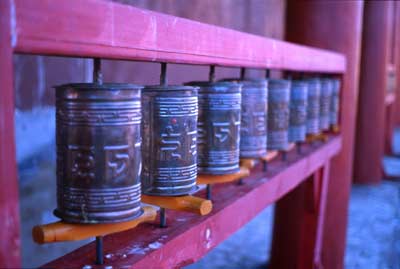

[In 2001 Jack Chance set out for a year of recording music, traveling from North Africa to the Himalayas by bus, boat, train, horse, camel, bicycle, and two sore feet. These are the sights, sounds, and stories he found in Mongolia (![]() =
= ![]() ).]
).]
![]() "Sankhu Golom- Reprise" Performed by Narangerel Buyanjargal
"Sankhu Golom- Reprise" Performed by Narangerel Buyanjargal
("Horse Song") Instrument: Yattag, 10/01 Ulaan Baatar (1:24)

Nearly 800 years ago, a powerful army swept across China and Central Asia. Surviving on the milk, blood, and meat of their horses, they reduced great cities to wasteland. They turned farm fields to desert, poured molten silver in the eyes of one enemy commander, and even threatened the Pope. At the height of their conquests, the great Khans controlled the largest land empire in recorded history, spanning from Korea to Hungary, Vietnam to Syria. They had sent spies into Venice and Vienna, when they suddenly vanished, returning to their homeland, the vast steppe of Mongolia.
It's October, six months into this music recording odyssey, I step off a Russian train to find myself in Ulaan Baatar, the modern day Mongolian capital. It's a cold blue morning. A bowlegged man leads a horse through city traffic. Street vendors shiver in their kiosks and restaurant signs bear the face of Genghis Khan, or Chinggis, as he's known here.

I walk to the Ganden Monastery, on the outskirts of town where the Soviet-era apartment blocks fade into camps of gers, the circular felt tents of the Mongolian nomad.
The monastery courtyard is surrounded by prayer wheels, engraved with Tibetan script. I'm greeted by a friendly monk, who's standing in a swirling cloud of pigeons, feeding them. On a wooden platform above us, two young lamas blow smoothworn seashells as the sun rises.
The monk invites me inside. I wonder if good karma keeps him from getting shat on. I remove my hat, remember to walk clockwise, and do my best to be respectful. The prayer hall smells of incense and yak butter. Lamas chant from buddhist scriptures and parents hush their children.
The prayers are broken by a sudden cacophonous blast of trumpets and percussion. This is called Tsam, which a monk describes to me as the sound of god. It's a call to awaken listeners from their illusions. Sort of a spiritual alarm clock, I'm thinking.
![]() Lamas (0:46) &
Lamas (0:46) & ![]() Tsam (0:19) at Ganden Monastery
Tsam (0:19) at Ganden Monastery
When Chinggis Khan first united the Mongol tribes in the early 13th century, his people practiced shamanism, similar to some Siberian and Native American traditions. We usually remember him as a cruel and cunning military general, but Chinggis also established a written language in Mongolia, a legal code, and a culture which tolerated many religions. His grandson, Kublai Khan, had advisors who were Christian, Muslim, Jewish, Confucian, and Taoist; but he became partial to Buddhism when, as the story goes, a Tibetan lama caused a wine glass to rise unaided through the air to the Khan's lips.
In 1578, in the midst of a crumbling empire, Altan Khan established Tibetan Buddhism as the official state religion -- strange since he was at war with Tibet at the time. Upon the spiritual leader, Sonam Gyatso, he bestowed the title Dalai Lama, meaning "ocean of wisdom."
This may have been a political move, but by then the Mongolian people were already blending Buddhism into their shamanistic rituals. At the time of the communist takeover in the 1920's, monasteries controlled one-fifth of the nation's wealth and it was customary for one son in every family to become a monk. But the Soviet-backed government killed thousands of monks, and "re-educated" thousands more. Of over 700 monasteries, only four survive today.

Walking out of the Monastery, I spot a small head peering out from a sewer vent. The boy yawns and surveys the morning traffic. His face looks frostbitten. The winters here are severe, so street kids find shelter and warmth in the city's underground sewer system. They sleep on cardboard beds draped over the hot water pipes. The fall of communism in 1990 gave Mongolians back their religion, but without a social welfare program, 4000 homeless children now roam Ulaan Baatar. There are several internationally funded orphanages, but many kids prefer the freedom of the streets.
I hand the kid a few togrog, the local currency, and head off to meet my friend and translator Baagii. We're recording a musician who plays the morin khoor, or "horse fiddle." It looks a little like a two string cello.
![]() Mongolian folk song Performed by Tumen Enkh music ensemble
Mongolian folk song Performed by Tumen Enkh music ensemble
Instruments: Khoomi, Morin Khoor, 10/01 Ulaan Baatar (3:38)
Legend tells of a herdsman who rode a winged steed. They would fly over the vast steppe, and the wind in the horse's mane would sing rich melodies. But the horse was killed by a jealous witch. The grieving shepherd built the first morin khoor out of the bones and hair of his dead companion, so that he might continue his song.
The eerie tone is called Khoomi, or throat singing. The singer produces overtones that can resonate deeply or whistle, depending on the tension of the vocal cords. An old man who sits in on the session tells me some shamans use these high overtones to represent a contact with the spirit world, while the bass note maintains a physical presence on the earth.
I ask Baagii why drums are seldom heard in secular Mongolian music. He says Mongolian songs sound best when sung on horseback, the drums are found in the rhythm of a horse's hooves.
audio/text/photos © 2001 Jack Chance
Chance's recordings will soon be available on the new CD:
Greetings from Elsewhere: An Asian Music Sampler